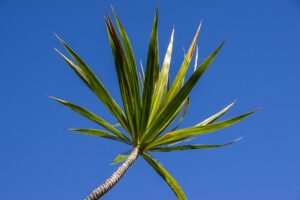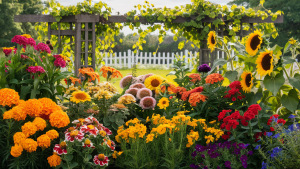This guide will explore some of the most popular flowering shrubs found throughout New England, exploring their unique characteristics, growing conditions, and care requirements, empowering you to enhance your garden with these remarkable plants.
Rhododendron
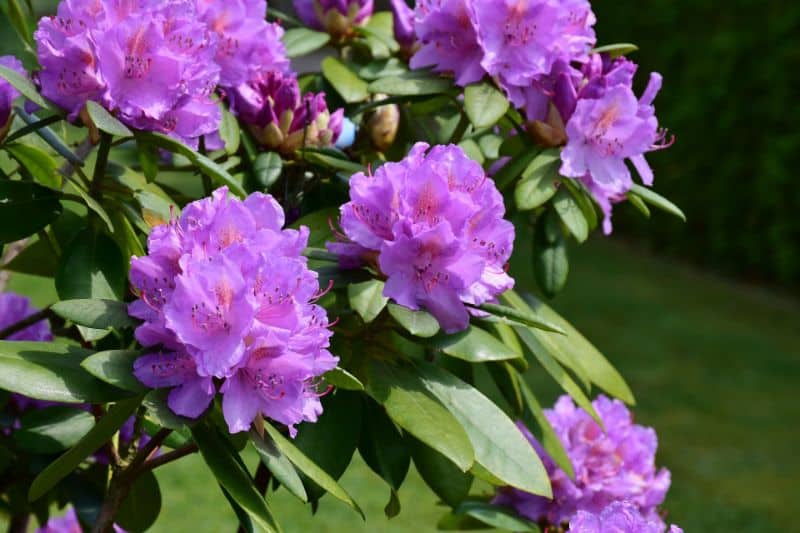
Rhododendrons are the show-stoppers of the New England landscape. Known for their large, truss-like clusters of flowers that bloom in a variety of hues—from pale pink to rich purple—these shrubs bring a splash of color to gardens every spring. They thrive in the acidic, well-drained soils prevalent in much of New England, making them particularly well-suited to the region.
When planting rhododendrons, consider choosing a location with partial shade to protect their leaves from the intense afternoon sun. These shrubs can grow quite tall, ranging from 3 to 15 feet depending on the species, so giving them ample space to reach their full glory is essential. Regular watering during the dry season will help maintain healthy blooms, and mulch can be beneficial for both moisture retention and weed suppression.
Not only do rhododendrons offer a stunning floral display, but they also provide year-round interest with their resilient evergreen foliage. Choosing heirloom varieties over hybrids can yield particularly robust plants that have been bred to withstand local conditions. If you want to add a touch of elegance to your space, few shrubs can compete with the majestic presence of the rhododendron.
Hydrangea

Hydrangeas are a beloved staple in New England gardens. Their ability to produce large, fluffy blooms in shades of blue, pink, white, and purple makes them a versatile choice for gardeners. The color of the bloom can even change based on the pH of the soil—acidic soils create blue flowers while alkaline soils produce pink ones.
These shrubs prefer well-drained soil and can often be found basking in full sun or partial shade. They are relatively low-maintenance but do appreciate regular watering, particularly during hot, dry spells. There are several species of hydrangeas, including the popular Hydrangea macrophylla, which is ideal for colder climates, and Hydrangea paniculata, known for its incredible hardiness and cone-shaped flower clusters.
Pruning hydrangeas can be a bit tricky since different species have distinct requirements. Knowing when and how to prune will encourage robust blooming in the following season. With their long flowering period from late spring to fall, hydrangeas provide stable beauty, making them a mainstay in many New England gardens.
Azaleas
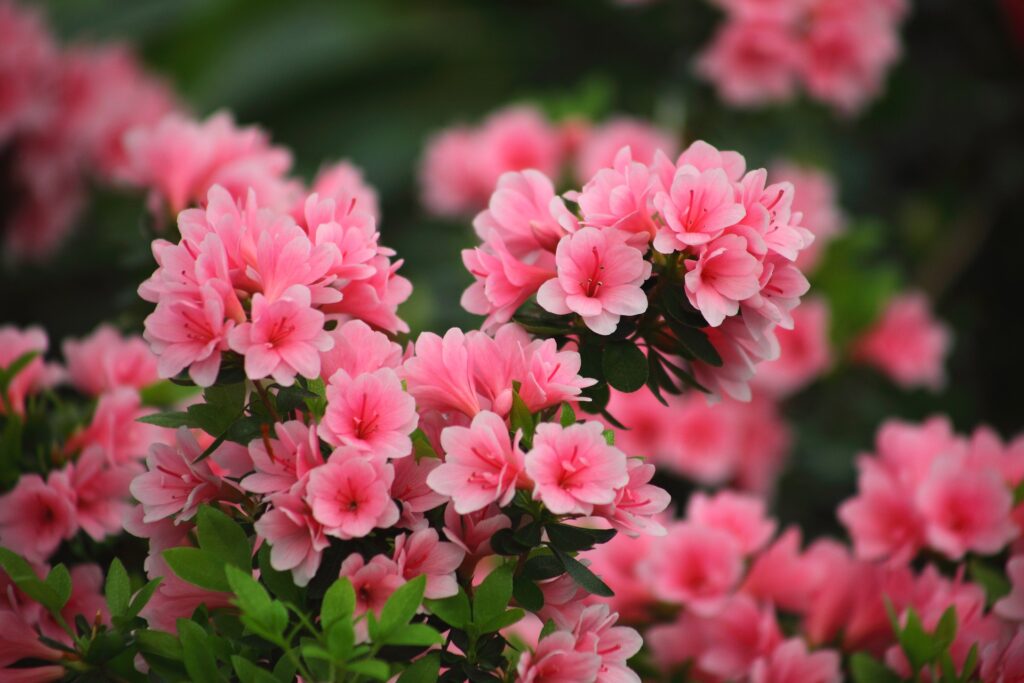
While azaleas are often grouped with rhododendrons, they deserve their own spotlight. These flowering shrubs are one of the earliest bloomers in New England, painting the landscape with vibrant hues from April through June. Azaleas are generally smaller than their rhododendron cousins, making them ideal for borders or smaller gardens.
Azaleas thrive in well-drained, acidic soil and prefer partial shade, especially in the hotter summer months. They are available in deciduous and evergreen varieties, providing an array of options for gardeners looking to enhance their landscapes. The vibrant blooms, which can be found in colors ranging from white to intense reds, attract pollinators like bees and butterflies, making your garden a haven for wildlife.
Care is relatively simple—just ensure they receive enough water and consider applying acidifying fertilizers to keep the soil conditions favorable. The beauty of azaleas isn’t just skin deep; their fragrant, delicate blooms provide a sensory delight that makes them an essential component of New England’s springtime gardens.
Mountain Laurel
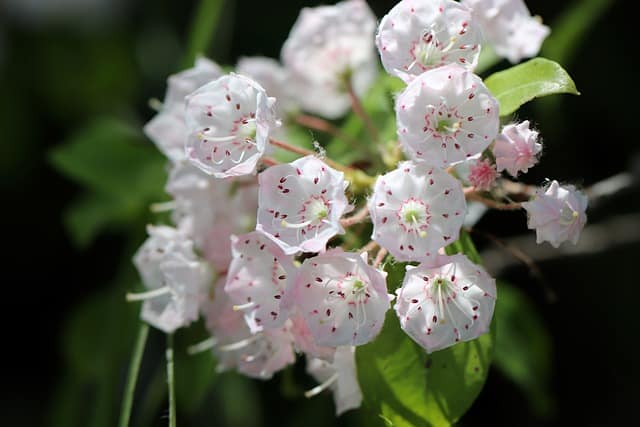
Mountain laurel (Kalmia latifolia) is the state flower of Connecticut, and for good reason. These evergreen shrubs offer stunning pink and white blooms that resemble miniature bouquets. Mountain laurel thrives in well-drained, acidic soils and can tolerate a range of light conditions from full sun to partial shade, making it an adaptable choice for various garden settings.
Often found in natural wooded areas, mountain laurel is a favorite among gardeners looking to recreate a rustic, naturalistic feel in their landscapes. This shrub can grow to be quite large, typically reaching a height of 5 to 15 feet, and has a unique ability to thrive in rocky or poor soils where other shrubs may struggle.
Regular watering and mulching help promote healthy growth, but once established, it is relatively low-maintenance. The allure of mountain laurel lies not only in its brilliant blooms from late spring to early summer but also in its glossy dark green leaves, which provide year-round visual interest. If you’re looking to create a serene and inviting garden space, mountain laurel can play a central role.
Winterberry
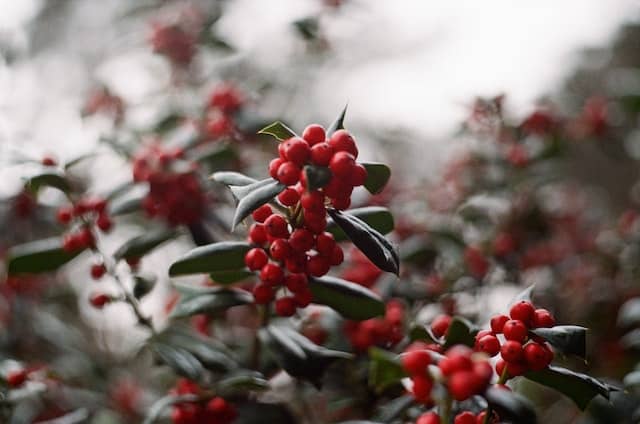
Winterberry (Ilex verticillata) stands out in the landscape, particularly in the winter months when its vibrant red berries remain on bare branches. This deciduous holly shrub thrives in wet, boggy soils and can tolerate a variety of light conditions, making it a versatile addition to any garden.
One of the most attractive features of winterberry is its ability to attract birds and other wildlife. The bright berries provide an important food source in the colder months when other resources are scarce. For winterberry to produce berries, you will need to plant both male and female plants, as only the female plants bear fruit.
Winterberry is relatively easy to care for, though it does appreciate some attention to soil moisture. Pruning is best done in early spring, allowing for an optimal flush of growth in the warmer months. The striking winter display of these shrubs, along with their ecological benefits, make them an ideal choice for those looking to create a wildlife-friendly garden.
Boxwood
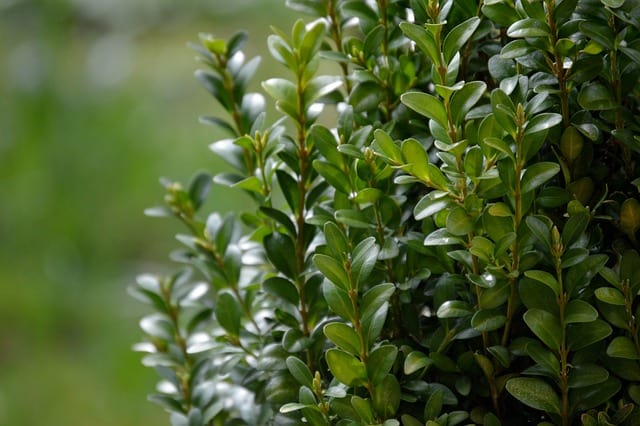
Boxwood (Buxus spp.) is a classic in New England gardens, often utilized for hedges, borders, and topiary. Known for its dense evergreen foliage, boxwood provides structure and color year-round. While it doesn’t flower like many of the shrubs on this list, its lush greenery plays a vital role in garden design.
Boxwoods thrive in well-drained soil and prefer partial to full sun. They are adaptable to various soil types, but proper drainage is key to preventing root rot, which can be a concern in wetter areas. Boxwoods can be pruned as desired, making them an excellent choice for gardeners who enjoy shaping their plants or creating formal gardens.
The rich green foliage can range from deep emerald to light lime, offering a variety of visual contrasts when paired with flowering plants. Incorporating boxwoods alongside flowering shrubs creates a balanced garden, providing both structure and seasonal interest.
Witch Hazel
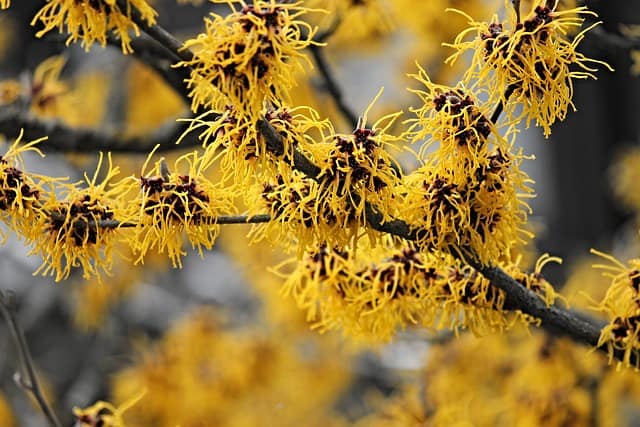
Witch hazel (Hamamelis) is an extraordinary shrub that offers a unique beauty, particularly in late winter and early spring. Its spidery flowers—often bright yellow or orange—emerge when most other plants remain dormant. These blooms not only add a burst of color but also attract early pollinators, making witch hazel invaluable for ecosystems.
Typically growing to a height of 10 to 20 feet, witch hazel prefers well-drained, loamy soil and a location that receives full sun to partial shade. This shrub is quite resilient, making it an excellent choice for gardeners of all skill levels. Its ability to thrive, even under less-than-ideal conditions, makes it a sturdy addition to any garden.
Fall foliage is another impressive aspect of witch hazel, as its leaves change to brilliant shades of yellow, orange, and red, providing year-round visual interest. When selecting plants for your landscape, consider the witch hazel for its unique blooming schedule and contribution to ecological health.
Juniper
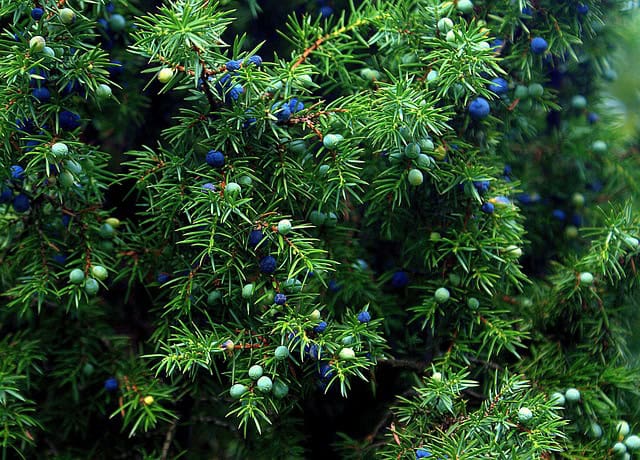
Junipers (Juniperus spp.) are an evergreen staple in New England gardens, known for their hardiness and versatility. With a wide range of species, these shrubs can be found in various shapes and sizes, from low-growing ground covers to taller, upright forms. Their dense foliage comes in shades of green, blue, and gold, offering significant design flexibility.
Junipers thrive in well-drained soils and are drought-tolerant, making them an excellent choice for dry, sunny areas of your garden. They are low-maintenance shrubs that require minimal pruning, making them ideal for busy homeowners. Given their resistance to pests and diseases, junipers can be a reliable and attractive option for many gardeners.
In addition to their ornamental appeal, junipers provide essential habitat for wildlife, offering shelter and nesting sites for birds and small creatures. Their ability to withstand harsh winter conditions adds to their value, making them a resilient option for adding year-round beauty to your landscape.
Holly
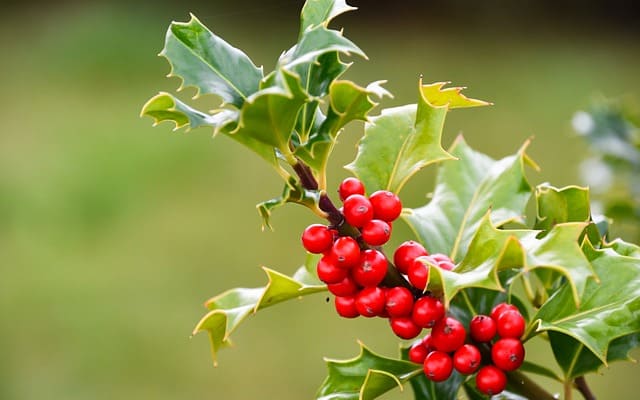
Holly (Ilex spp.) is synonymous with winter holidays, but this stunning shrub is much more than festive decoration. With its glossy, spiny-leaved evergreen foliage and vibrant red berries, holly adds color and texture to gardens year-round. Various holly species flourish in New England, including the American holly and the inkberry holly.
Hollies thrive in well-drained, rich soils and prefer locations that receive full sun to partial shade. While the female plants produce the iconic red berries, it is vital to plant male varieties nearby for pollination. These shrubs require minimal maintenance, occasional pruning to maintain shape, and watering during dry spells to ensure robust growth.
Beyond their ornamental value, holly bushes are excellent for attracting wildlife, providing shelter for birds and other small animals. With their striking winter beauty and ecological benefits, hollies make a wonderful addition to any New England landscape.
Lilac
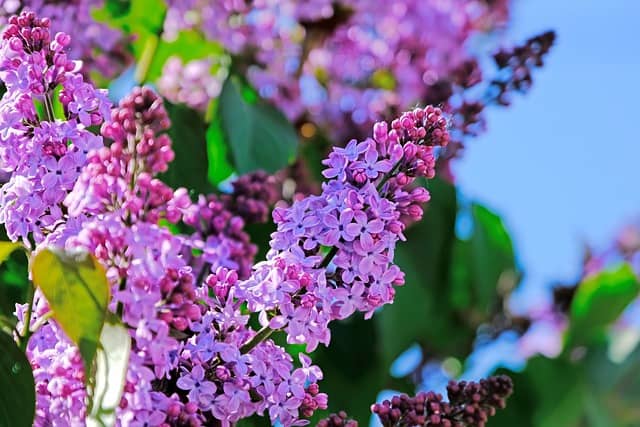
Lilacs (Syringa spp.) are cherished throughout New England for their delightful fragrance and vibrant springtime blooms. From deep purples to soft lavenders and even white, lilacs give gardens an enchanting charm. These deciduous shrubs thrive in full sun and well-drained soil, making them a favorite among avid gardeners.
Lilacs typically exhibit a compact growth habit, reaching heights of 4 to 10 feet, making them perfect for hedges, borders, or stand-alone accents. They are relatively low-maintenance, requiring pruning after flowering to encourage healthy growth and abundant blooms the following year.
The intoxicating scent of lilacs in spring has a nostalgic quality that many New Englanders cherish, often evoking fond memories of childhood gardens. Incorporating lilacs into your landscape not only provides aesthetic beauty but also creates a sensory experience that enhances the overall joy of gardening.
Fothergilla
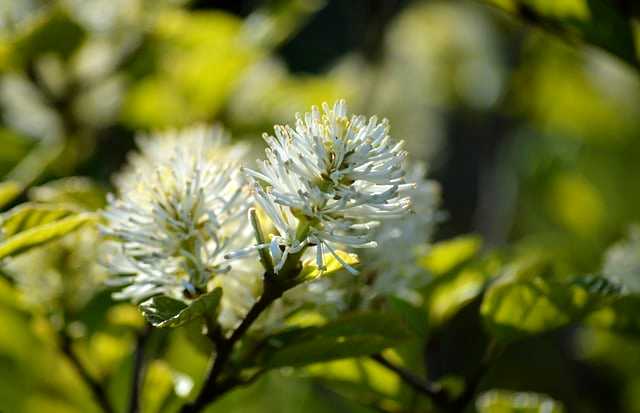
Fothergilla is a lesser-known gem among New England flowering shrubs, often overshadowed by its more popular counterparts. This unique shrub offers aromatic white flowers in spring, resembling fluffy tassels. It thrives in moist, well-drained soils and prefers partial to full sun.
One of the most appealing aspects of fothergilla is its glorious fall foliage. As the cooler months arrive, this shrub showcases vibrant hues of yellow, orange, and red, offering a breathtaking display. Fothergilla typically reaches heights of 3 to 5 feet, making it suitable for borders or as a low-maintenance screen in a garden.
Since fothergilla is relatively drought-tolerant once established, it requires little care and attention. Its unique flowering structure and stunning fall color make it a distinctive choice for gardeners looking for something a little different.
Spirea

Spireas are some of the most versatile flowering shrubs available, often praised for their resilience and ease of care. With a wide array of species exhibiting different sizes, shapes, and bloom colors, spirea is perfect for adding summer-long interest to your garden. Their clusters of small flowers, which come in shades of pink, white, and red, are highly attractive to pollinators.
These shrubs thrive in full sun to partial shade and prefer well-drained soil, making them adaptable to various environmental conditions. Pruning is usually done at the start of spring to encourage a healthy and compact growth habit. They generally bloom from late spring to early summer, and some varieties, like the Japanese spirea, continue to produce flowers well into fall.
Spireas not only provide impressive floral displays but also grow quickly and are often used for erosion control or as low-maintenance landscape fillers. Their versatility, hardiness, and ability to adapt to New England’s changing seasons make them a popular choice among gardeners.



